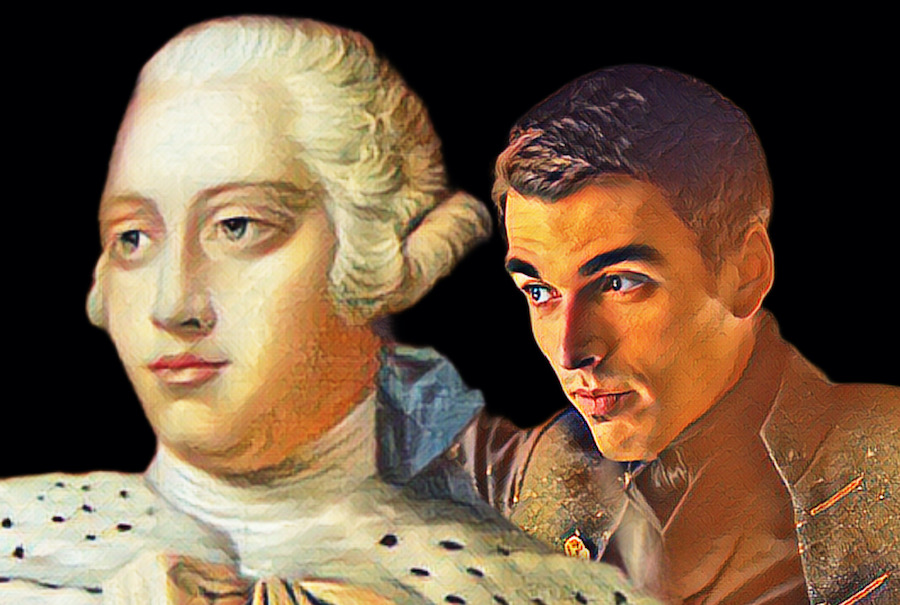“George III is widely remembered for two things: losing the American colonies and going mad. This is far from the whole truth.”
The description above is from the website of the British Royal Family. About American independence, there are disagreements about the monarch’s responsibility for “losing the American colony” and sustaining the war against France, but about his sanity – or the loss of it – is a fact. The nature of the problem is still in dispute today, identified in outbreaks between 1788-89, then in 1801 until, again using the official words, he became “mentally unfit to rule”. Another fact? His happy marriage to Queen Charlotte is precisely the subject of the new Netflix miniseries that is billed as “a Bridgerton story“. Much of the information about the couple in the series is correct, by the way.
Queen Charlotte has only six episodes, all of them traveling back and forth in time between to recount how the sovereign arrived from Germany to marry the young King, how they fell in love, and yes, how was the delicate issue of his health. Tied in with Bridgerton‘s original content, there’s no way to end it without being emotional and heartfelt tears rolling down your cheeks. It’s romantic, it’s sad, it’s inspiring and it’s perfect. Yeah, it’s better than Bridgerton. But let’s get back to George.


As in the series and play (from 1991) and in the film (The Madness of King George, from 1994), it is never clear what took George III’s sanity. One current – the most common – points out that his mental instability was caused by a hereditary physical disorder called porphyria (on the official website it is what they say). Other bets on bipolar disorder, something that only found a more accurate definition in the 21st century. Anyway, as we see in the reports, the king suffered doubly: for the illness that afflicted him and for the painful and inefficient methods to try to treat it.
As many know, the family tree of the British Royal Family is essentially German. So much so that George III was effectively the first of the Hanoverian line to be born in London and to use English as his first language. On his father’s death in 1751, before George II became king, it was George III who ascended to the throne in 1760, aged just 22. Obviously, one of the first decisions was to find a bride. The chosen one was Sophia Charlotte of Mecklenburg-Strelitz, from a small German duchy and who was only 17 years old.
Charlotte arrived in England in 1761 after a difficult journey marred by storms and other challenges. The wedding ceremony was held a few hours after her disembarkation, in the Royal Chapel of the Palace of St. James. The two were crowned in September and the following year, the first of 15 children was born. Although St James Palace was the official residence of the royal couple, George III presented Charlotte with a nearby property, Buckingham House, which with the birth of George IV, came to be called Buckingham Palace (or ‘The Queen’s House’ ). Before turning to the two, one more real estate curiosity that experts from the Royal Family will appreciate. It was Queen Charlotte who bought Frogmore House in Windsor. But let’s get back to the couple.


It would be natural for the relationship between George and Charlotte to be cold or just friendly, but by all accounts, it is clear that it was a love match and the King was completely devoted to his wife and children. We can even say that Netflix’s Queen Charlotte showed the love story of the two very well. Both were lovers of reading – George is considered one of the most cultured monarchs in history, with a collection of around 65,000 books, later donated to the British Museum; Art, the king founded and paid the initial costs of the Royal Academy of Arts, and Music, yes, they both liked Handel, yes the Queen’s master of music was Johann Christian Bach, and YES, at just eight Mozart performed for Charlotte, as shown in Bridgerton, and he dedicated his Opus 3 to the Queen. In addition, George III was the first king to study science and have his own astronomical observatory (as in the series) and Charlotte was passionate about botany, having renovated the gardens of Kew Palace (known at the time as Dutch House). Another correct point of Queen Charlotte‘s narrative was to show the king’s passion for agriculture, which earned him the nickname ‘Farmer George’.
When they were married, the instability of George III’s mental health was a secret kept even from his wife. Their first and temporary crisis happened in the first few years they were together, as the series shows. The fear of how he would look was probably behind a bill of 1765 that would pass the regency to Charlotte in case the king became permanently unable to rule, something that generated a conflict that Bridgerton does not show, after all, it only happens 13 years after the series, but which is the heart of the story of the play and film, The Madness of King George. What happened was that in 1788, during one of the King’s crises, the Queen and the Prince of Wales disagreed over who would have the regency. The Queen had the upper hand and George “returned to normal”, but from 1811, the madness was permanent and her son ruled the Crown.
Charlotte personally cared for her husband until his death in 1818. George III, who was blind in later years, died just two years after the Queen. The two are buried in St George’s Chapel at Windsor Castle.

George III’s question of what his health problem actually was, due to its secrecy, has little data to help with a retrospective diagnosis. For many years, after discovering the high levels of arsenic in the mortal remains of the monarch, specialists firmly point out that his outbreaks were caused by congenital porphyria after all there are more cases in the royal Houses of Stuart, Hanover, and Prussia, of which the king was part of. However, because arsenic was a common medicine at the time and because, according to the first documented record, in 1855, there was the conclusion that the King suffered from “acute mania”, today it is more accepted that King George III’s health problem was a bipolar disorder. In fact, he could have it both ways. Queen Charlotte doesn’t go into detail about what’s going on and in The Madness of King George, the credits say he had porphyria, describing the condition as “periodic, unpredictable and hereditary”.
Anyway, what’s beautiful is rescuing the love between him and Charlotte, which is completely true and a necessary love story for hopeless days. On the heart side, there was no madness at all. Just unconditional love. Beautiful.
